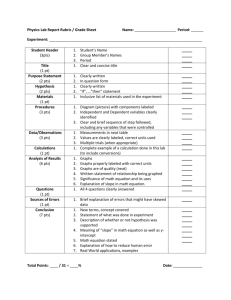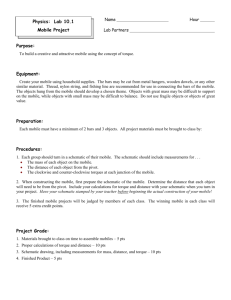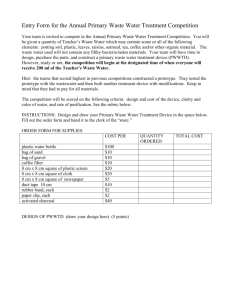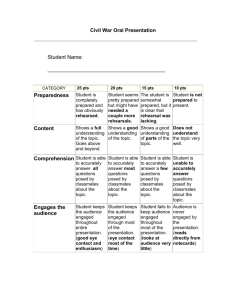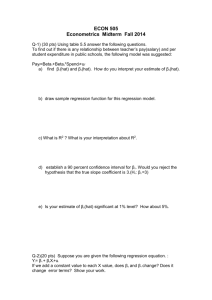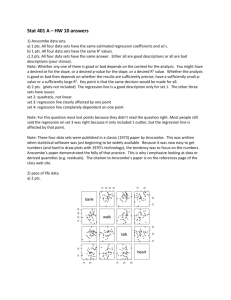Test 1f13anwers
advertisement
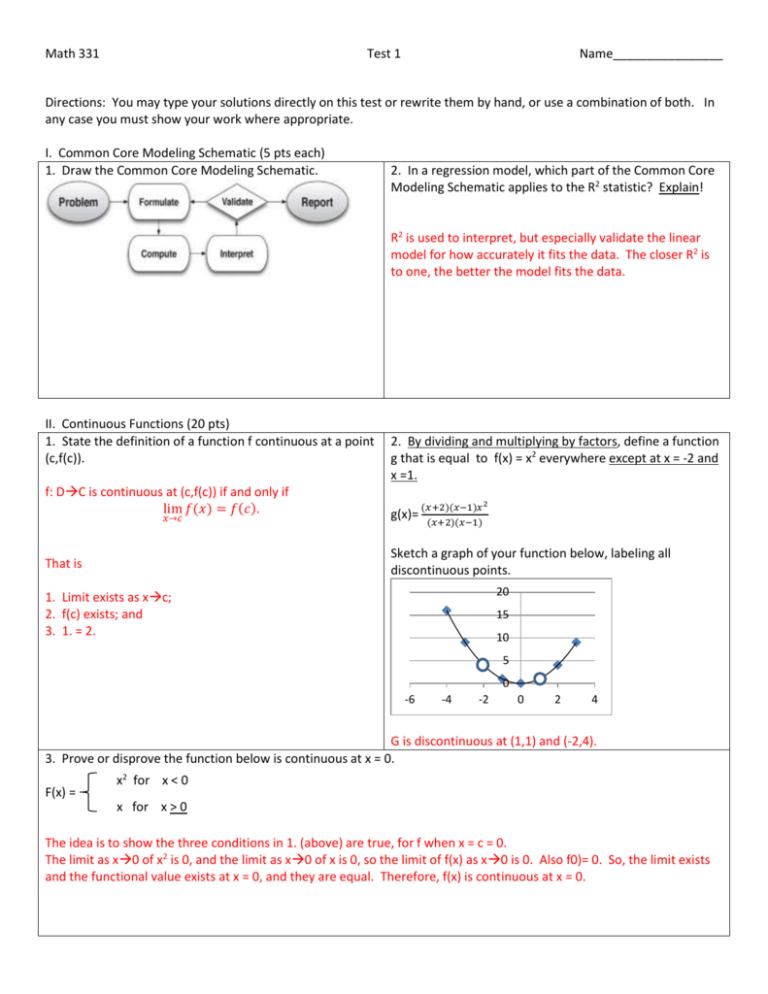
Math 331 Test 1 Name________________ Directions: You may type your solutions directly on this test or rewrite them by hand, or use a combination of both. In any case you must show your work where appropriate. I. Common Core Modeling Schematic (5 pts each) 1. Draw the Common Core Modeling Schematic. 2. In a regression model, which part of the Common Core Modeling Schematic applies to the R2 statistic? Explain! R2 is used to interpret, but especially validate the linear model for how accurately it fits the data. The closer R2 is to one, the better the model fits the data. II. Continuous Functions (20 pts) 1. State the definition of a function f continuous at a point (c,f(c)). 2. By dividing and multiplying by factors, define a function g that is equal to f(x) = x2 everywhere except at x = -2 and x =1. f: DC is continuous at (c,f(c)) if and only if lim 𝑓(𝑥) = 𝑓(𝑐). g(x)= That is Sketch a graph of your function below, labeling all discontinuous points. 𝑥→𝑐 (𝑥+2)(𝑥−1)𝑥 2 (𝑥+2)(𝑥−1) 20 1. Limit exists as xc; 2. f(c) exists; and 3. 1. = 2. 15 10 5 0 -6 -4 -2 0 2 4 G is discontinuous at (1,1) and (-2,4). 3. Prove or disprove the function below is continuous at x = 0. F(x) = x2 for x < 0 x for x > 0 The idea is to show the three conditions in 1. (above) are true, for f when x = c = 0. The limit as x0 of x2 is 0, and the limit as x0 of x is 0, so the limit of f(x) as x0 is 0. Also f0)= 0. So, the limit exists and the functional value exists at x = 0, and they are equal. Therefore, f(x) is continuous at x = 0. Math 331 Test 1 Name________________ III. Regression 1. Briefly, but carefully and accurately, outline the stepwise process leading to linear regression coefficients in a 2-D model. State all equations and matrices accurately. (15 pts) 1. The main idea is to minimize the SSRes, which is the sum of squares of all the residual values. 𝑛 2 2 SSres =∑𝑛𝑖=1(𝑦𝑖 − 𝑦̂) 𝑖 =∑𝑖=1(𝑦𝑖 − 𝑚𝑥𝑖 − 𝑏) 2. Take the partial derivatives of SSRes with respect to m and b and set equal to 0 to find the local minimum of the paraboloid. 𝛿𝑆𝑆𝑅𝑒𝑠 =2 ∑𝑛𝑖=1(𝑦𝑖 𝛿𝑚 − 𝑚𝑥𝑖 − 𝑏)2 (−𝑥𝑖 ) = 0 𝛿𝑆𝑆𝑅𝑒𝑠 =2 ∑𝑛𝑖=1(𝑦𝑖 𝛿𝑏 − 𝑚𝑥𝑖 − 𝑏)2 (−1) = 0 𝑚 3. Solve for the vector of coefficients [ ]. 𝑏 ∑𝑛𝑖=1(−𝑥𝑖 𝑦𝑖 + 𝑚𝑥𝑖2 + 𝑏𝑥𝑖 ) = 0 𝑛 ∑(−𝑦𝑖 + 𝑚𝑥𝑖 + 𝑏)2 = 0 𝑖=1 Suppressing the subscript I, we have: 2 [∑ 𝑥 ∑𝑥 ∑ 𝑥 ] [𝑚] = [∑ 𝑥𝑦] 𝑏 ∑𝑦 1 and, finally 2 𝑚 [ ] = [∑ 𝑥 𝑏 ∑𝑥 ∑𝑥 ] 1 −1 [ ∑ 𝑥𝑦 ] ∑𝑦 Math 331 Test 1 2. Your pilot has landed her Cessna 172 on a 1600 ft airfield, bordered by tall trees, which sits at an altitude of 10,250 ft above sea level. She wants to depart at 2pm, fully loaded, when the temperature is predicted to be 35 degrees Centigrade. Should you ride with her? Explain why or why not. (10 pts) Name________________ 3. What rate of climb should the Cessna 172 pilot expect at 10,250 ft above sea level when the air temperature is 35 degrees Celcius? (There are lots of mountains around!) (10 pts) From the 3-D linear model, the climb rate would be approximately 160 ft/min. From the 3-D linear model, the ground roll would be approximately 4011 ft. Do not go! 4. As Earth’s population continues to grow, the solid waste generated Year by the population grows with it. Governments must plan for disposal and recycling of ever growing amounts of solid waste. Planners can use data from the past to predict future waste generation and plan for enough facilities for disposing of and recycling the waste. Given the following data on the waste generated in Florida from 19901994, construct a function to predict the waste that was generated there in the year 2012? Comment on the accuracy and limitations of your model. (20 pts) 1990 1991 1992 1993 1994 2012 State your model. State the accuracy of your model. y = 304.93x2 - 1E+06x + 1E+09 R² = 0.9991 Tons of Solid Waste Generated (in thousands) 19,358 19,484 20,293 21,499 23,561 What (obviously) limits extrapolation here? Missing data between 1994 and the extrapolation. IV. Separation of Variables. Derive the solution to dP/dt = kP, subject to the conditions: P(0) = 1,221 and P(2) = 5,580. Show all work! (15 pts) dP/dt = kP dP/P = kdt ∫ 1 𝑑𝑃 = ∫ 𝑘 𝑑𝑡 Ln|P| = kt + C Since P> 0, P(t) = ekt+C. So, P(t) = Poekt. (This is the exponential growth model. Use the two initial conditions to find Po and k.) P(0) = Po = 1221, and P(2) = 1221e2k = 5580, so k ~ .760 Consequently, the growth model is P(t) = 1221e.760t.





